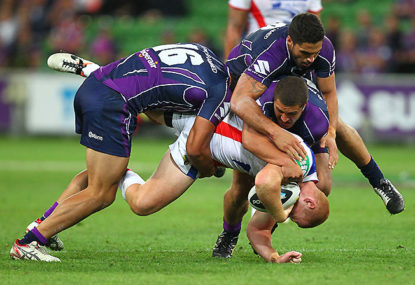Stoinis clubs stunning IPL ton, makes tough chase look a cinch with clutch final-over barrage
Marcus Stoinis produced his first IPL century and it was a beauty. He went 6, 4, 4, 4 to finish off the Lucknow Super…

No matter how extremely unlikely the tragic death of Phil Hughes was, we must be honest that it would be even more unlikely for something like this to never happen.
Phil Hughes is not the first to die on the sporting field, and he won’t be the last.
From tennis to rugby to cricket, ‘faster, higher, stronger’ is the resounding demand of the modern sporting-industrial complex. Yes, that would be ours – your catch-cry and mine.
In this complex, aggression is a virtue.
Needless to say, of course, that when one bowls a bouncer or goes in for a tackle, the intent is never to cripple, maim or kill an opponent. But it can’t be denied that there is often intent to intimidate, to scare, even to hurt.
Upon landing on these shores last week, Virat Kohli, the Indian captain, spent nearly his entire press conference emphasising “aggression” and “fight”. The Australian captain, Michael Clarke, who has been in the news for good reasons and bad this week, once angrily told his opponent on the field to “get ready for a broken fucking arm”.
In Aussie rules, players often talk about ‘making your opponent feel your tackle’. Coaches, meanwhile, spout many mantras in this game, but perhaps none more so than ‘being hard at the ball and hard at the man’.
“If you’re hard at the ball and you’re hard at the man,” lamented shell-shocked Sydney Swans coach John Longmire after his team was humbled by Hawthorn in this year’s grand final.
Aggression then is an attitude, an intent that moderates one’s actions on the sporting field.
Of course, serious injury – and even death – is more likely in some games than in others. But the plausible ways in which death could occur on the field are several, and are not inconceivable in sports ranging from hockey to Aussie rules to rugby to boxing to American football to cricket.
In recent years, some commentators have seriously raised the prospect that bowlers and umpires should wear protective gear (including helmets). The power with which some batsmen now smash the ball back down the ground is unprecedented. In Aussie rules, too, it is universally acknowledged that the game today is harder and faster than it ever was. The effects of concussion and other traumatic brain injuries on american football players, meanwhile, have been widely documented.
And we have to accept our role in both these potentialities and realities. Our insatiable appetite for hard, tough, uncompromising, gladiatorial sporting combat has, at least in part, fuelled the increasingly dangerous nature of modern professional sport. The heavier bats. The stronger bodies. The more aggressive attitudes.
Meanwhile, at pubs we talk dispassionately of concussions and broken limbs, dehumanised facts that matter only to the extent that they impact on one team’s prospects or another’s. Heck, even Gary Rohan is back running like he was never nearly crippled.
Sadly, it has taken a tragic death to give us a little perspective, a little humanity. But it’s unlikely to stem the inexorable march of the faster, higher, stronger. Yes, the skills are forever improving, but some of the risks are also new and greater.
So, in the end we are left with the uncomfortable knowledge that life on the sporting field – and perhaps more broadly – is but a sequence of events through which we somehow manage to cheat death until, sooner or later, we don’t.